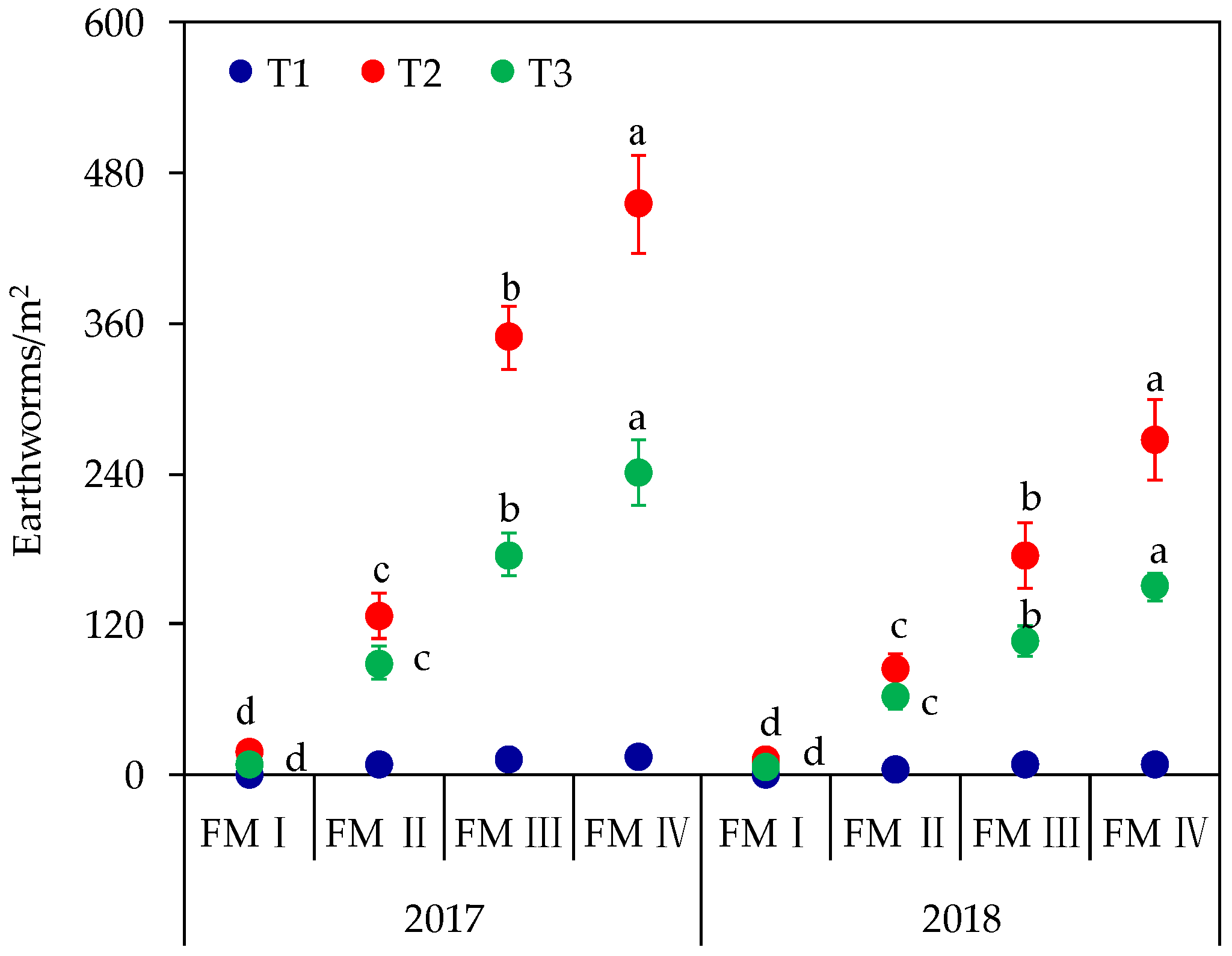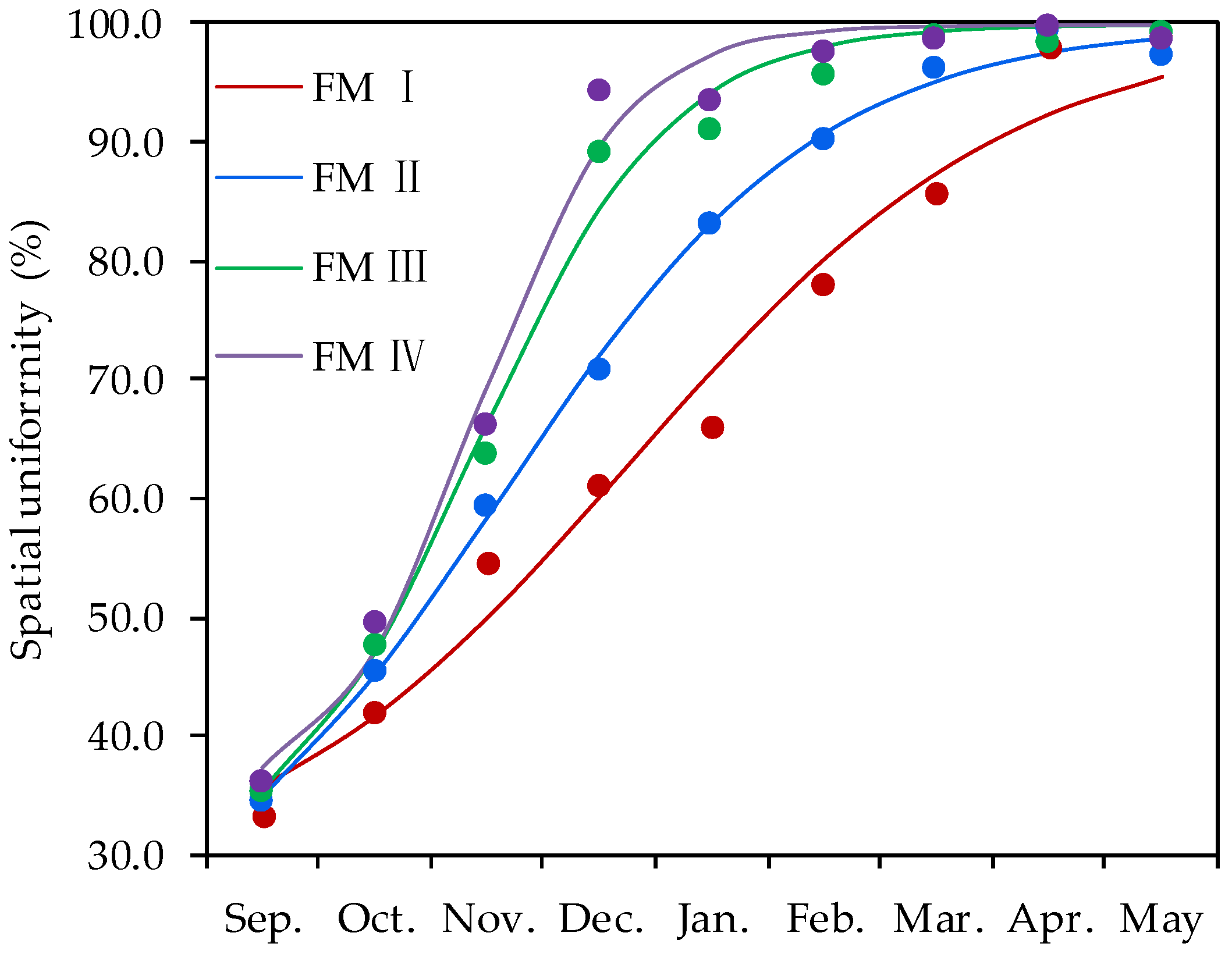Expansion of Field Margin Size Mitigate the Hazard of Rotary Tillage to Earthworm in Rice-Rape Rotation System
Abstract
1. Introduction
2. Materials and Methods
2.1. Study Area
2.2. Earthworms Migration between FM and AF
2.3. Experimental Design
2.4. Earthworm Sampling
2.5. Statistical Analysis
3. Results
3.1. Earthworms Refuge in Response to FM Size
3.2. Earthworms Mortality in Response to FM Size Induced by Rotary Tillage
3.3. Earthworm Population Recovery of AF in Response to FM Size
4. Discussion
4.1. Importance of FM and Effect of Its Sizes on Earthworms Refuge
4.2. Influence of FM Size on Mitigating the Harmful Effects of Rotary Tillage on Earthworms
5. Conclusions
Author Contributions
Funding
Institutional Review Board Statement
Informed Consent Statement
Data Availability Statement
Acknowledgments
Conflicts of Interest
References
- Yasmin, S.; Souza, D.D. Effects of pesticides on the growth and reproduction of earthworm: A review. Appl. Environ. Soil Sci. 2010, 2010, 678360. [Google Scholar] [CrossRef]
- Li, Y.; Wang, J.; Shao, M. Assessment of earthworm as indicator of soil degradation: A case study on loess soils. Land Degrad. Dev. 2021, 32, 2606–2617. [Google Scholar] [CrossRef]
- Piron, D.; Boizard, H.; Heddadj, D.; Pérès, G.; Hallaire, V.; Cluzeau, D. Indicators of earthworm bioturbation to improve visual assessment of soil structure. Soil Tillage Res. 2017, 173, 53–63. [Google Scholar] [CrossRef]
- Bertrand, M.; Barot, S.; Blouin, M.; Whalen, J.; Oliveira, T.D.; Roger-Estrade, J. Earthworm services for cropping systems. A review. Agron. Sustain. Dev. 2015, 35, 553–567. [Google Scholar] [CrossRef]
- Briones, M.J.I.; Schmidt, O. Conventional tillage decreases the abundance and biomass of earthworms and alters their community structure in a global meta-analysis. Glob. Chang. Biol. 2017, 23, 4396–4419. [Google Scholar] [CrossRef]
- Lobry de Bruyn, L.A.; Kingston, T.J. Effects of summer irrigation and trampling in dairy pastures on soil physical properties and earthworm number and species composition. Aust. J. Agr. Res. 1997, 48, 1059. [Google Scholar] [CrossRef]
- Huynh, H.T.; Hufnagel, J.; Wurbs, A.; Bellingrath-Kimura, S.D. Influences of soil tillage, irrigation and crop rotation on maize biomass yield in a 9-year field study in Müncheberg, Germany. Field Crop. Res. 2019, 241, 107565. [Google Scholar] [CrossRef]
- Wang, X.; Jing, Z.; He, C.; Liu, Q.; Zhang, H. Temporal variation of SOC storage and crop yield and its relationship—A fourteen year field trial about tillage practices in a double paddy cropping system, China. Sci. Total Environ. 2020, 759, 143494. [Google Scholar] [CrossRef]
- Huang, M.; Zhao, C.; Zhou, X.; Chen, G.; Zou, Y.; Uphoff, N. Earthworm responses to cropping rotation with oilseed rape in no-tillage rice fields and the effects of earthworm casts on human-essential amino acid content in rice grains. Appl. Soil Ecol. 2018, 127, 58–63. [Google Scholar] [CrossRef]
- Huang, M.; Zhao, C.; Zou, Y.; Uphoff, N. Yield effect of applying earthworm castings produced during the oilseed rape-growing season in rice-oilseed rape cropping fields to rice. Sci. Rep. 2018, 8, 10759. [Google Scholar] [CrossRef]
- Zorn, M.I.; Van Gestel, C.A.M.; Eijsackers, H. Species-specific earthworm population responses in relation to flooding dynamics in a Dutch floodplain soil. Pedobiologia 2015, 49, 189–198. [Google Scholar] [CrossRef]
- Darwin, C. The Formation of Vegetable Mould through the Action of Worms, with Observations of Their Habits; Murray: London, UK, 1881. [Google Scholar]
- Bostrm, U. Earthworm populations (Lumbricidae) in ploughed and undisturbed leys. Soil Tillage Res. 1995, 35, 125–133. [Google Scholar] [CrossRef]
- Prendergast-Miller, M.T.; Jones, D.T.; Berdeni, D.; Bird, S.; Chapman, P.J.; Firbank, L.; Grayson, R.; Helgason, T.; Holden, J.; Lappage, M.; et al. Arable fields as potential reservoirs of biodiversity: Earthworm populations increase in new leys. Sci. Total Environ. 2021, 789, 147880. [Google Scholar] [CrossRef] [PubMed]
- Crittenden, S.J.; Huerta, E.; De Goede, R.G.M.; Pulleman, M.M. Earthworm assemblages as affected by field margin strips and tillage intensity: An on-farm approach. Eur. J. Soil Biol. 2015, 66, 49–56. [Google Scholar] [CrossRef]
- Nuutinen, V.; Butt, K.R.; Jauhiainen, L. Field margins and management affect settlement and spread of an introduced dew-worm (Lumbricus terrestris L.) population. Pedobiologia 2011, 54, S167–S172. [Google Scholar] [CrossRef]
- Huang, J.; Xu, Q.; Sun, Z.J.; Wang, C.; Zheng, D.M. Research on earthworm resources of China: I. Checklist and distribution. J. China Agric. Univ. 2016, 11, 9–20. [Google Scholar]
- Lee, K.E. Earthworms: Their Ecology and Relationship with Soils and Land Use; Academic Press: Sydney, NJW, Austrilia, 1985. [Google Scholar]
- Sim, R.W.; Gerard, B.M. Earthworms: Keys and notes for the identification and study of the species. N. Z. J. Zool. 1985, 15, 447–448. [Google Scholar]
- Harvey, R.J.; Chadwick, D.R.; Sánchez-Rodríguez, A.R.; Jones, D.L. Agroecosystem resilience in response to extreme winter flooding. Agr. Ecosyst. Environ. 2019, 279, 1–13. [Google Scholar] [CrossRef]
- Kiss, T.B.; Chen, X.; Ponting, J.; Sizmur, T.; Hodson, M.E. Dual stresses of flooding and agricultural land use reduce earthworm populations more than the individual stressors. Sci. Total Environ. 2021, 754, 142102. [Google Scholar] [CrossRef]
- Clapperton, M.J. Tillage practices, and temperature and moisture interactions affect earthworm populations and species composition. Pedobiologia 1999, 43, 658–665. [Google Scholar]
- Vri, S.; Breznik, M.; Pulko, B.; Rodrigo-Comino, J. Earthworm abundance changes depending on soil management practices in slovenian vineyards. Agronomy 2021, 11, 1241. [Google Scholar]
- Uvarov, A.V.; Tiunov, A.V.; Scheu, S. Effects of seasonal and diurnal temperature fluctuations on population dynamics of two epigeic earthworm species in forest soil. Soil Biol. Biochem. 2011, 43, 559–570. [Google Scholar] [CrossRef]
- Presley, M.L.; Mcelroy, T.C.; Diehl, W.J. Soil moisture and temperature interact to affect growth, survivorship, fecundity, and fitness in the earthworm Eisenia fetida. Comp. Biochem. Physiol. A Comp. Physiol. 1996, 114, 319–326. [Google Scholar] [CrossRef]
- Noordijk, J.; Musters, C.J.M.; van Dijk, J.; De Snoo, G.R. Invertebrates in field margins: Taxonomic group diversity and functional group abundance in relation to age. Biodivers. Conserv. 2010, 19, 3255–3268. [Google Scholar] [CrossRef]
- Bäckman, J.C.; Tiainen, J. Habitat quality of field margins in a Finnish farmland area for bumblebees (Hymenoptera: Bombus and Psithyrus). Agric. Ecosyst. Environ. 2002, 89, 53–68. [Google Scholar] [CrossRef]
- Ma, M.; Tarmi, S.; Helenius, J. Revisiting the species–area relationship in a semi-natural habitat: Floral richness in agricultural buffer zones in Finland. Agric. Ecosyst. Environ. 2022, 89, 137–148. [Google Scholar] [CrossRef]
- Tian, G.; Kang, B.; Brussaard, L. Effect of mulch quality on earthworm activity and nutrient supply in the humid tropics. Soil Biol. Biochem. 1997, 29, 369–373. [Google Scholar] [CrossRef]
- Lagerlöf, J.; Goffre, B.; Vincent, C. The importance of field boundaries for earthworms (Lumbricidae) in the Swedish agricultural landscape. Agric. Ecosyst. Environ. 2002, 89, 91–103. [Google Scholar] [CrossRef]
- Roarty, S.; Schmidt, O. Permanent and new arable field margins support large earthworm communities but do not increase in-field populations. Agric. Ecosyst. Environ. 2013, 170, 45–55. [Google Scholar] [CrossRef]
- Steinwandter, M.; Jäger, S.; Schlick-Steiner, B.C.; Steiner, F.M.; Seeber, J. Low-quality dwarf-shrub litter negatively affects the fitness of Alpine earthworms (Lumbricus rubellus Hoffmeister, 1843; Oligochaeta: Lumbricidae). Appl. Soil Ecol. 2019, 139, 79–84. [Google Scholar] [CrossRef]
- Szlavecz, K.; Chang, C.; Bernard, M.J.; Pitz, S.L.; Xia, L.; Ma, Y.; Mccormick, M.K.; Filley, T.; Yarwood, S.A.; Yesilonis, I.D.; et al. Litter quality, dispersal and invasion drive earthworm community dynamics and forest soil development. Oecologia 2018, 188, 237–250. [Google Scholar] [CrossRef] [PubMed]
- Chen, Y.; Cao, J.; He, X.; Liu, T.; Shao, Y.; Zhang, C.; Zhou, Q.; Li, F.; Mao, P.; Tao, L.; et al. Plant leaf litter plays a more important role than roots in maintaining earthworm communities in subtropical plantations. Soil Biol. Biochem. 2020, 144, 107777. [Google Scholar] [CrossRef]
- Hubbard, V.C.; Jordan, D.; Stecker, J.A. Earthworm response to rotation and tillage in a Missouri claypan soil. Biol. Fert. Soils 1999, 29, 343–347. [Google Scholar] [CrossRef]
- Eriksen-Hamel, N.S.; Speratti, A.B.; Whalen, J.K.; Légère, A.; Madramootoo, C.A. Earthworm populations and growth rates related to long-term crop residue and tillage management. Soil Tillage Res. 2009, 104, 311–316. [Google Scholar] [CrossRef]







| Item | 2016 | 2017 | 2018 | |||||||||
|---|---|---|---|---|---|---|---|---|---|---|---|---|
| Jun.–Aug. | Sep. | Oct. | Nov.–Dem. | Jan.–Apr. | May | Jun.–Aug. | Sep. | Oct. | Nov.–Dem. | Jan.–Apr. | May | |
| Cropping management | RT1, H1, DS1 | H2, RT2, DS2 | RT3, H3, DS3 | H4, RT4, DS4, | ||||||||
| Sampling date | 1 | 2, M1 | 3–4 | 5–8 | 9 | M2 | 10 | |||||
| Years | FM Size | Earthworm Abundance | Total Biomass | Individual Biomass |
|---|---|---|---|---|
| (Earthworms/m2) | (g/m2) | (g/Individual) | ||
| 2017 | FM I | 8.4 ± 1.1 d | 4.32 ± 0.28 d | 36.3 ± 3.9 d |
| FM II | 45.3 ± 3.6 c | 3.46 ± 0.09 c | 156.9 ± 8.6 c | |
| FM III | 79.0 ± 5.9 b | 3.21 ± 0.06 b | 253.2 ± 13.8 b | |
| FM IV | 98.5 ± 7.4 a | 3.11 ± 0.07 a | 306.3 ± 16.5 a | |
| 2018 | FM I | 4.7 ± 0.6 d | 4.64 ± 0.23 d | 21.8 ± 1.7 d |
| FM II | 22.4 ± 2.0 c | 3.99 ± 0.14 c | 89.3 ± 5.4 c | |
| FM III | 38.3 ± 2.6 b | 3.60 ± 0.04 b | 137.9 ± 8.1 b | |
| FM IV | 51.8 ± 3.5 a | 3.38 ± 0.06 a | 175.1 ± 9.8 a |
Publisher’s Note: MDPI stays neutral with regard to jurisdictional claims in published maps and institutional affiliations. |
© 2022 by the authors. Licensee MDPI, Basel, Switzerland. This article is an open access article distributed under the terms and conditions of the Creative Commons Attribution (CC BY) license (https://creativecommons.org/licenses/by/4.0/).
Share and Cite
Li, C.; Zhao, Y.; Cheng, K.; Zhou, J.; Xiao, X.; Iqbal, A.; Tang, H.; Huang, M. Expansion of Field Margin Size Mitigate the Hazard of Rotary Tillage to Earthworm in Rice-Rape Rotation System. Agronomy 2022, 12, 2209. https://doi.org/10.3390/agronomy12092209
Li C, Zhao Y, Cheng K, Zhou J, Xiao X, Iqbal A, Tang H, Huang M. Expansion of Field Margin Size Mitigate the Hazard of Rotary Tillage to Earthworm in Rice-Rape Rotation System. Agronomy. 2022; 12(9):2209. https://doi.org/10.3390/agronomy12092209
Chicago/Turabian StyleLi, Chao, Yang Zhao, Kaikai Cheng, Junyu Zhou, Xiaoping Xiao, Anas Iqbal, Haiming Tang, and Min Huang. 2022. "Expansion of Field Margin Size Mitigate the Hazard of Rotary Tillage to Earthworm in Rice-Rape Rotation System" Agronomy 12, no. 9: 2209. https://doi.org/10.3390/agronomy12092209
APA StyleLi, C., Zhao, Y., Cheng, K., Zhou, J., Xiao, X., Iqbal, A., Tang, H., & Huang, M. (2022). Expansion of Field Margin Size Mitigate the Hazard of Rotary Tillage to Earthworm in Rice-Rape Rotation System. Agronomy, 12(9), 2209. https://doi.org/10.3390/agronomy12092209






